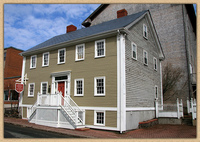Knaut-Rhuland House Museum
(Museum)
The museum owned and managed by the Lunenburg Heritage Society serves as an example of early life in Lunenburg.
(Museum)
The Knaut-Rhuland House is valued for its age, architectural style and previous ownership by well-known residents of Lunenburg. On the exterior it has many of the features of the New England Colonial style, yet it is unmistakeably Georgian in its interior layout and floor plan.Knaut-Rhuland House was built in 1793-1794 by Benjamin Knaut, a merchant and sheriff of Lunenburg. He was the son of one of the most prominant foreign Protestants to settle Lunenburg in 1753, Philip Augustus Knaut. Philip Knaut was the first elected member from Lunenburg to the Nova Scotia Assembly of Representatives..
Benjamin Knaut sold this house in 1813 to Conrad Rhuland, a mariner and privateer. Rhuland was the grandson of another of Lunenburg's original settlers. Rhuland made significant changes in the downstairs front parlour, reflecting the regional Vernacular German style of the first quarter of the 19th century.n 1823, Rhuland sold the house to John W. Creighton. As a member in the Assembly for Lunenburg County, Judge of Probate, President and Speaker of the Legislative Council, and finally as a Member of the Executive Council (Cabinet), Creighton was an important provincial politician from 1830 until his death in 1867. The house remained in the Creighton family until 1906
The Knaut Room (left room from entrance)
In 1907, the house was sold to the Independent Order of Odd Fellows. It is now a museum owned and managed by the Lunenburg Heritage Society and serves as an example of early life in Lunenburg..
The house has been designated a National Historic Site by the Historic Sites and Monuments Board of Canada due to its historical importance. It has also been designated a Registered Heritage Property by the province of Nova Scotia and a Municipal Heritage Property by the Town of Lunenburg. It is one of the best-preserved eighteenth-century houses in Canada, built in the Colonial, Palladian style.
